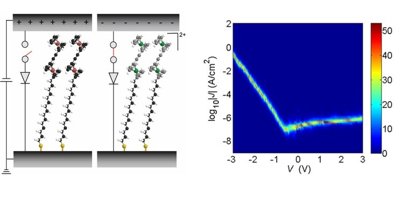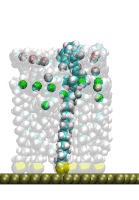Switches are one of the cornerstones of electrical circuitry, but it has been notoriously difficult to develop molecular switches that perform well in junctions. For many years we have worked on molecular diodes (Acc. Chem. Res. 2016, 49, 2061–2069) which can be seen as a switch that allows the current to flow in only one bias direction, but in recent years we have also investigated other types of switches including junctions based on spin cross over compounds (Chem. Sci. 2021, 12, 2381-2388), or phase transitions and magnetoresistance biomolecules (J. Phys.: Mater. 2021, 4, 035003 and J. Mater. Chem. C 2021, DOI: 10.1039/D0TC05773H). In upcoming technologies, such as, neuromorphic computing, it is important to development new types of molecular switches that can reduce the footprint of devices, decrease power consumption, and enable complementary functionalities to existing solutions. We are developing new types of molecular switches that can toggle between multiple functionalities (Appl. Phys. Lett. 2020, 117, 030502). For instance, we created a dual-functional molecular switch that works as both a diode and a memory element (Nat. Mater. 2020, 19, 843-848). The device is only 2 nm thick and only requires a low drive voltage of less than 1 V, a significant improved over other 1D-1R memory devices. The Figure on the right shows this dual-functional switch that is based on dimerization of viologens in conjunction with directional migration of the counterions resulting in stable states and non-volatile memory. The panel in the middle show that a two-step switching mechanism results in highly hysteretic behavior (memory) only at negative bias (because of the diode functionality). The panel on the right shows that the junctions can reversibly be switched between conductive states (R1 and R2) by applying the respective write (W) and erase (E) voltages.

Dual-functionality can also be used to improve the performance of molecular devices. For instance, for decades molecules diodes were inferior to diodes based on semi-conductors in terms of the rectification ratio. By combining a diode functionality in series with an electrostatic on/off switch (panel on the left), we improved the diode by more than 2 orders of magnitude with similar performance as traditional diodes (Nat. Nanotechnol. 2017, 12, 797–803) as shown in the middle panel. This example nicely showcases the importance of the dynamics of molecular junctions where charging of the result in electrostatic repulsion and an increase in the monolayer thickness (panel on the right). This increase in thickness is the drive-force behind the electrostatic switch because it pins the ferrocene headgroups of the monolayer to the top electrode.


Currently, we are developing dynamical molecular switches with the aim to mimic synaptic behaviour and to develop reconfigurable junctions.
